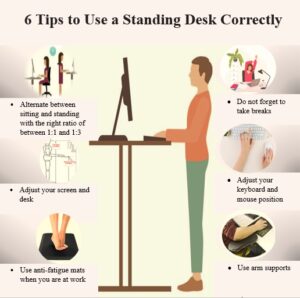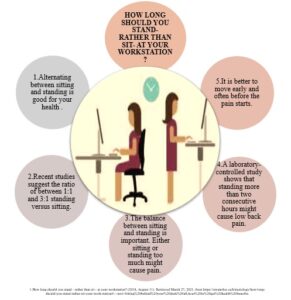HOW SHOULD I USE MY STANDING DESK TO AVOID PAIN?
Written by Melis.
Sitting at the work has become a habit and most of us have maintained this for ages without thinking that might cause health problems. The scientists have been carrying on their studies to minimize this problem for so long. Although there are different views about how long you should stand at your workstation, the recent studies suggest the ideal sit-stand ratio that is between 1:1 and 1:3 to decrease problems related to sitting. To give an example, if you work for 8 hours shift, you should stand for 30 to 45 minutes per hour. It is important to mention that prolonged and uninterrupted standing also might cause chronic back problems later. A laboratory- controlled studies showed that 50% of participants who did not have previous back pain and were asked to stand at an ergonomic desk for 2 consecutive hours developed lower back pain.
5 tips to use standing desk correctly:
-
Alternate between sitting and standing:
By keeping mind of the right ratio of between 1:1-1:3, you should try to alternate between sitting and standing to avoid low back pain.
-
Keep your posture in the right position while standing:
Standing desk should be set at your elbow height, the top of your screen should be at your eye level, with a tilt of between 10-20 degrees to keep your head neutral, mouse and keyboards should be at the same level and wrist is straight when typing. Do not forget that the right position of wrist is slightly tilted upwards in standing.
-
Use anti-fatigue mats while you are at work:
If you must stand up for long periods, you can use anti-fatigue mats to reduce back pain and tiredness and improve blood-flow.
-
Use arm supports:
Using the arm supports attached to the desk can reduce pressure on the wrist and avoid the risk of neck and shoulder problems.
-
Do not forget to take breaks:
It does not matter whether you are sitting or standing, always remember to take breaks to move, stretch and rest your eyes. Using automated reminders for your breaks might be helpful not to miss it.
In addition to these, sudden and drastic changes about sitting and standing might cause more severe and chronic back pain problems in future. To avoid this, Jack Callaghan, a professor in Waterloo’s Department of Kinesiology, recommends moving early and often which means that you should move and change your position before the pain starts.
If you are still experiencing lower back pain, sciatica, neck or shoulder pain even after following those tips, CONTACT-US! A well-trained physiotherapist will be able to help you.
Don’t live in pain anymore! Click here to ask for an appointment!

Sources [1] How long should you stand – rather than sit – at your work station? (2018, August 11). Retrieved March 27, 2021, from https://uwaterloo.ca/kinesiology/how-long-should-you-stand-rather-sit-your-work-station#:~:text=Sitting%20behind%20your%20desk%20all,hour%20to%20get%20health%20benefits


Recent Comments